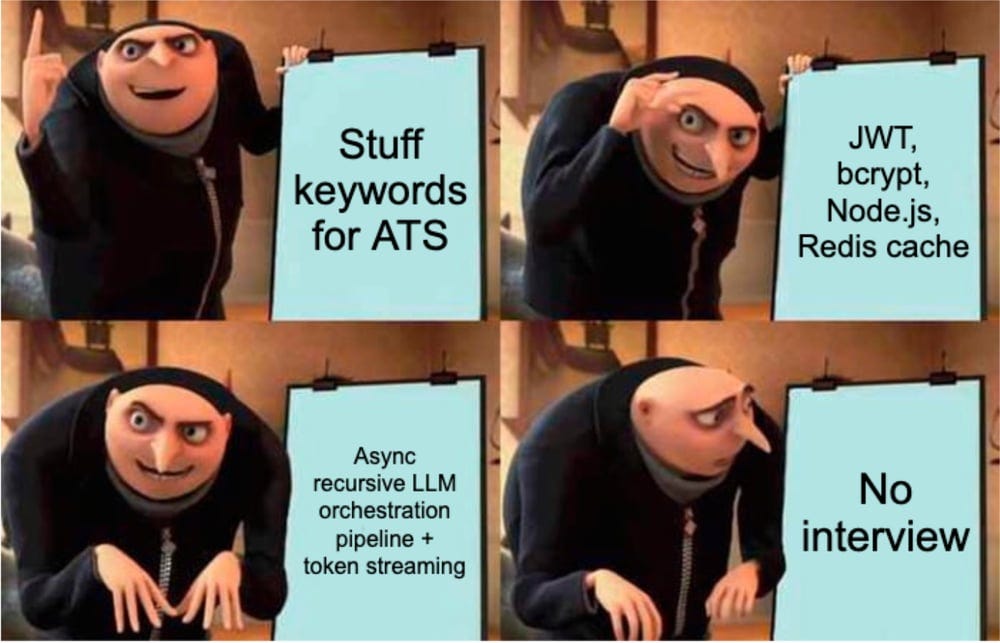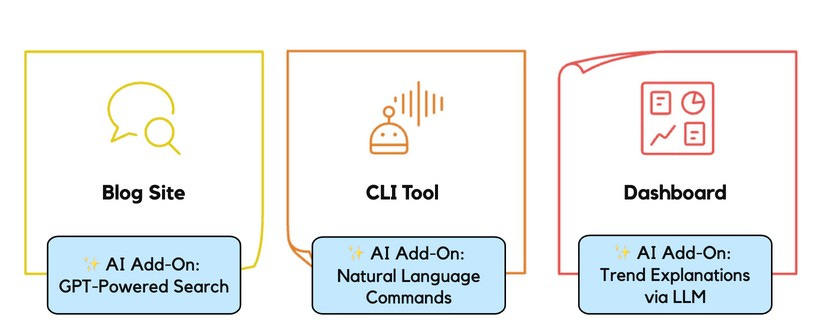Want to get hired in 2025? 5 tips from a tech leader.
How to prove you can build in the AI era.
Note: This post was originally published on Medium.
AI has changed what gets you hired.
Back in 2010, the right tech stack and a solid portfolio could get you interviews.
But that's not enough anymore.
Today’s hiring managers aren't just vetting your fit for the role — they’re assessing your readiness for the AI era. You need to prove you can use AI to adapt fast and think strategically in an increasingly automated future.
As a tech founder with several friends in leadership, I can tell you: AI skills are now table stakes for developer roles. But that alone won’t get you in the room.
So how can you signal hireability?
These 5 strategies will get you noticed — and hired — in 2025 and beyond.
1. Optimize your resume for ATS AND recruiters
It doesn't matter how impressive your resume is.
It won't get seen if it's not optimized for two audiences:
Applicant Tracking Systems (ATS): These scan for keywords to match your skills with the job description.
Recruiters: They take just seconds to scan your resume, and if they're lost in technical jargon, they won't select you.
Lots of candidates make the mistake of stuffing their resume with keywords for ATS, forgetting that recruiters aren't technical experts.
For example, this phrase would make recruiters' eyes glaze over:
❌ “Implemented authentication leveraging bcrypt encryption and rotating JWT tokens in a Node.js environment.”
The key is striking a balance between technical specificity speaking in layman's terms:
✅ "Built a secure login system using Node.js, bcrypt, and JWTs, reducing account-related support requests by 40%.”
To capture both ATS and recruiters' attention, you should:
Explain your impact in layman’s terms (what you did and why it mattered).
Mention tools, frameworks, and keywords from the job description (yes, include AI/LLM experience if relevant).
Use standard section headers like "Experience" and "Education" so ATS don’t get confused.
💡 AI tip: Use your preferred LLM to tailor resumes with keywords for a job description, or rewrite descriptions in layman's terms.
2. A portfolio that proves you can build with AI
77% of leaders would rather have a candidate with less years of experience than someone without AI skills.1
AI skills are no longer optional. But it’s not enough to just list skills—you need to prove that you can build with them.
Start by choosing the problems you want to solve or systems you want to build, then layer in the relevant AI capabilities:
LLM API Integration: Build a chatbot, support agent, or writing tool that streams responses from APIs like OpenAI or Anthropic.
Orchestration Frameworks: Create tools that connect models to data and logic with LangChain or LlamaIndex.
Retrieval-Augmented Generation (RAG): Build intelligent documentation or search tools with contextual answers using ChromaDB, LangChain, or LlamaIndex.
Model Tuning & Customization: Adapt base models for your domain—like summarizing research papers or generating code—with Hugging Face Transformers or LoRA.
Agent Orchestration: Design autonomous systems that use tools, complete tasks, or collaborate across workflows using LangGraph or CrewAI.
Generative AI System Design: Architect large-scale GenAI systems or multi-agent platforms with tailored UX and infrastructure needs.
These projects don’t need to be enterprise-grade. They just need to show initiative, adaptability, and curiosity.
You can also consider adding AI functionalities to an existing project:
Add AI-powered search or autocomplete to a blog, portfolio site, or docs using embeddings or GPT.
Enhance a CLI tool or script with natural language commands.
Add plain-language trend explanations to a dashboard.
🤝 If agent orchestration is on your radar, build this to save time job hunting and impress employers: Build a Multi-Agent Job Search System with CrewAI and Python.
3. Strengthen your tech chops for the interview
In a 45-min interview, you need to send hireable signals fast.
Here's what stands out to me in interviews:
In-depth problem solving: When candidates aren't blindly going through the motions from a similar Leetcode problem, but really understand the nuance to why a solution works for a particular context (i.e., coding patterns).
System Design knowledge: A MAJOR plus in entry-level candidates, even when they're not even in a System Design interview. In a world where juniors will get an earlier chance to think on the design level, considering the long-term challenges of scaling an app is a green flag.
Generative AI interest: Mentioning how a product could be improved by AI, or asking what initiatives are underway at the company.
When it comes to showcasing problem-solving skills, the best way to train this is also is the same way to streamline your prep at home—it's pattern-based interview prep, which involves learning the underlying patterns to various problems:
Coding patterns: In coding interviews, a single coding pattern can help you unlock thousands of problems.
Design patterns: Software design patterns give you a leg up in System Design Interviews and beyond.
💡 AI tip: Do on-demand mock interviews with AI and get personalized feedback. Try an AI mock interview for free at mockinterviews.dev.
4. Flex your soft skills
I don't remember the candidate who perfectly memorized a complex BFS + memoization combo. I remember the one who was a creative thinker, communicated clearly, and made me feel like they'd be a great teammate during a 2 a.m. production incident.
In a market where everyone knows the same stack, soft skills set you apart.
Think:
Adaptability: Can you stay calm and pivot when your first idea fails?
Clarity: Can you explain your thinking to a PM or junior dev without sounding condescending?
Collaboration: Do you ask good questions and make space for other people's ideas?
Growth mindset: Can you take constructive criticism without getting defensive?
This means you can't underestimate the behavioral interview:
Learn what hiring managers are actually looking for in this free behavioral interview course.
Use AI to simulate the behavioral interview and ask you culture fit questions for specific companies.
But soft skills don't just matter in behavioral interviews. They're also critical in design interviews, which are communication-heavy by nature. In these rounds, we're looking for how well you navigate ambiguity, take initiative to clarify, and respond to feedback—so practice and mock interviews are key to getting this right.
👉 As an ex-MAANG tech founder with 17+ years of experience with System Design Interviews, I share soft skills that signal hireability in my free guide: System Design Interview Handbook.
Bottom line: Technical skills alone won't get you hired.
5. Do deep research with AI
Don’t just tell me you care about the job. Show it through research.
When a candidate asks me, “Have you explored using RAG to deliver personalized answers from your course catalog or forums?” — I know they did more than hit Ctrl+F on the company blog.
Here’s how standout candidates use AI to do research:
Make tailored suggestions during interviews: Great for technical interviews where you want to ask or pitch something memorable.
Example prompt: “What are innovative ways [company] could integrate LLMs into their product suite? Why?”
Prep like a PM: Understand the ecosystem, talk strategy, and show you’re thinking beyond code.
Example prompt: “Summarize [company]’s key competitors and how they differentiate themselves in terms of AI features."
Research the team’s stack and challenges: This is gold in a System Design interview.
Example prompt: “What tech stack does [company/team] use based on job posts and GitHub repos? What challenges would arise when scaling it?”
Research is powerful for writing a custom cover letter and resume, but it especially makes you pop in the interview stage when you get a chance to ask questions directly.
Beyond resourcefulness with AI, doing your research shows me that you have the initiative and curiosity that can help you onboard quickly on the job.
Not just fit for the job — Fit for the future
If you want to stand out in today's competitive market, you'll need to:
Craft resumes that connect with both ATS and real humans
Build a portfolio that proves you can build with AI
Interview like someone who understands the “why,” not just the “how”
Show soft skills that make you a high-trust teammate
Use AI like a Staff Engineer to research, strategize, and signal initiative
These aren't just signals of job-readiness. They’re signals of someone who's ready for the AI-powered future.
You can also start building your AI portfolio today with Educative Projects.
By the way, we’re running a sale right now. Here's a link to get 50% off Educative subscriptions for projects, courses, mock interviews, and more.
Happy learning!
- Fahim




